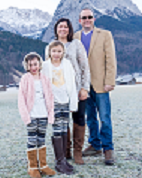- Calls to this hotline are currently being directed to Within Health, Fay or Eating Disorder Solutions
- Representatives are standing by 24/7 to help answer your questions
- All calls are confidential and HIPAA compliant
- There is no obligation or cost to call
- Eating Disorder Hope does not receive any commissions or fees dependent upon which provider you select
- Additional treatment providers are located on our directory or samhsa.gov
Maudsley Model in Eating Disorder Treatment

The Maudsley Model (or Family Based Therapy, for which it is more commonly referred to) is an evidence based, intensive outpatient refeeding treatment program where parents and/or caregivers play an active and positive role in aiding in restoring their child’s weight to normal and expected levels, help control their child’s eating and return to teen when appropriate, and encourage normal teen development through family therapy [1, 3].
The goal of therapy is to prevent hospitalization of the teen and help their child recovery from their eating disorder. This therapy was founded at the Maudsley Hospital in London by child and adolescent psychiatrists and psychologists. In clinical trials, ⅔ of patients who completed and recovered using the Family Based Therapy (FBT), and 70-90% of that group were continuing with recovery at the five year follow up [1].
Effectiveness of the Maudsley Model for Eating Disorder Treatment
When families are dealing with a child who is suffering from an eating disorder, the symptoms begin to play a central role in family life. Parents and siblings begin to see normalcy disappear, and interactions around food start to dominate all family relationships. It is important in this process to see how families organize themselves around the eating disorder [2].
 Parents are seen as the most committed and competent people in the child’s life, as well as the best qualified to combat the eating disorder and restore their child’s weight and health. FBT is a highly structured therapy that usually involves the family working together for up to 1 year to help their child recovery from an eating disorder.
Parents are seen as the most committed and competent people in the child’s life, as well as the best qualified to combat the eating disorder and restore their child’s weight and health. FBT is a highly structured therapy that usually involves the family working together for up to 1 year to help their child recovery from an eating disorder.
The family can consist of immediate and extended family, primarily the adults who are the primary caregivers for the ill child. FBT is recommended for children under the age of 19, and have added a new therapy, the New Maudsley Method.
FBT is most effective when it is done within the first three years of the illness beginning. Parents are deemed with the task of weight restoration and re feeding their child. Siblings act as a support for their ill brother or sister [1,4].
Phases of Family Based Therapy
There are three phases within the FBT model. Phase one is weight restoration where through, 15-20 treatment session where the therapist focuses on education and dangers associated with the eating disorder, mostly Anorexia Nervosa. The therapist works to engage the parents in weight restoration and refeeding process while at the same time working to build a therapeutic alliance with the patient and other family members [1].
During this phase, the therapist observes the family’s typical meal patterns, verbal and nonverbal interaction patterns, and works to help the parents gain new skills in combating the eating disorder. The main concept is to mimic inpatient treatment in the home by using sympathy, compassion, and understanding by the parents to the child around food and the eating disorder. It is teaching the parents the necessity of consistency and that starvation or not eating is also not an option.
 Phase II is when control over eating is returned to the adolescent. This phase is typically signalled when the child shows acceptance of parental control, and increase of food intake, shows steady weight gain, and changes in mood and temperance are consistent [1]. The focus during this phase is on encouraging the parents to help their child take a more active role in eating again.
Phase II is when control over eating is returned to the adolescent. This phase is typically signalled when the child shows acceptance of parental control, and increase of food intake, shows steady weight gain, and changes in mood and temperance are consistent [1]. The focus during this phase is on encouraging the parents to help their child take a more active role in eating again.
The therapist assists the parents to accept the main task is to return their child to physical health. Weight gain is not the main focus and family sessions are directed toward relationship issues, dynamics, and normal age-stage concerns. Issues within the family that were postponed in the beginning will be discussed during this phase.
Phase III is when the adolescent can look at and develop their identify. Treatment focus is shifted to the child and personal self development. This can include increasing personal autonomy, development of appropriate parental and family boundaries and finding the family’s new normalcy after the eating disorder. [1].
Goals of the Maudsley Method
The New Maudsley Method is an additional treatment for parents, caregivers, and clinicians and is used in adjunct to treatment. The goal of the New Maudsley Approach is to reduce stress and empower the patient [4]. This treatment is focuses primarily on the young adult and those suffering with Bulimia Nervosa. This approach works on the more instilled disordered patterns of the illness. Its focus is to help the patients loved ones engage their own intrinsic motivation to change [5, 6]. This method works to train parents, spouses, and other family members to better support the individual.
 Studies conducted on the long term efficacy rates of FBT, have shown that over 50% of patients who received FBT, were in full remission after completing the program[6]. 120 AN patients were studied at the University of Chicago and Stanford University and test the FBT efficacy. FBT and control therapies were conducted with regular sessions for 1 year. At the end of the 1 year period, those enrolled in the FBT therapy showed fewer hospitalization compared to the control group [6].
Studies conducted on the long term efficacy rates of FBT, have shown that over 50% of patients who received FBT, were in full remission after completing the program[6]. 120 AN patients were studied at the University of Chicago and Stanford University and test the FBT efficacy. FBT and control therapies were conducted with regular sessions for 1 year. At the end of the 1 year period, those enrolled in the FBT therapy showed fewer hospitalization compared to the control group [6].
In conclusion, the FBT model has high recovery rates, and low relapse rates at five year post-treatment. It is highly effective in treating eating disorders in children and adolescents and works with the family system to create a support system and recovery team. It is necessary as a clinician to seek training in the FBT model to ensure proper facilitation and effectiveness.
Community Discussion – Share Your Thoughts Here!
If you have used the Maudsley Model, what have you found to be most helpful in therapy? What tools and tips do you have for other clinicians wanting to use this therapy technique?
 About the Author: Libby Lyons, MSW, LCSW, CEDS is a specialist in the eating disorder field. Libby has been treating eating disorders for 10 years within the St. Louis area, and enjoys working with individuals of all ages.
About the Author: Libby Lyons, MSW, LCSW, CEDS is a specialist in the eating disorder field. Libby has been treating eating disorders for 10 years within the St. Louis area, and enjoys working with individuals of all ages.
References:
[1]: http://www.maudsleyparents.org/whatismaudsley.html[2]: http://thenewmaudsleyapproach.co.uk/Research_Rationale.php
[3]: http://www.feast-ed.org/?page=FBT_MaudsleyApproach
[4]: http://bodymatters.com.au/what-is-the-difference-between-the-maudsley-family-based-treatment-and-the-new-maudsley-method/
[5]: http://www.kcl.ac.uk/ioppn/about/difference/16-Training-for-carers-of-people-with-anorexia.aspx
[6]: http://www.uchospitals.edu/news/2010/20101004-maudsley.html
The opinions and views of our guest contributors are shared to provide a broad perspective of eating disorders. These are not necessarily the views of Eating Disorder Hope, but an effort to offer discussion of various issues by different concerned individuals.
We at Eating Disorder Hope understand that eating disorders result from a combination of environmental and genetic factors. If you or a loved one are suffering from an eating disorder, please know that there is hope for you, and seek immediate professional help.
Last Updated & Reviewed By: Jacquelyn Ekern, MS, LPC on January 8, 2017.
Published on EatingDisorderHope.com

The EatingDisorderHope.com editorial team comprises experienced writers, editors, and medical reviewers specializing in eating disorders, treatment, and mental and behavioral health.

